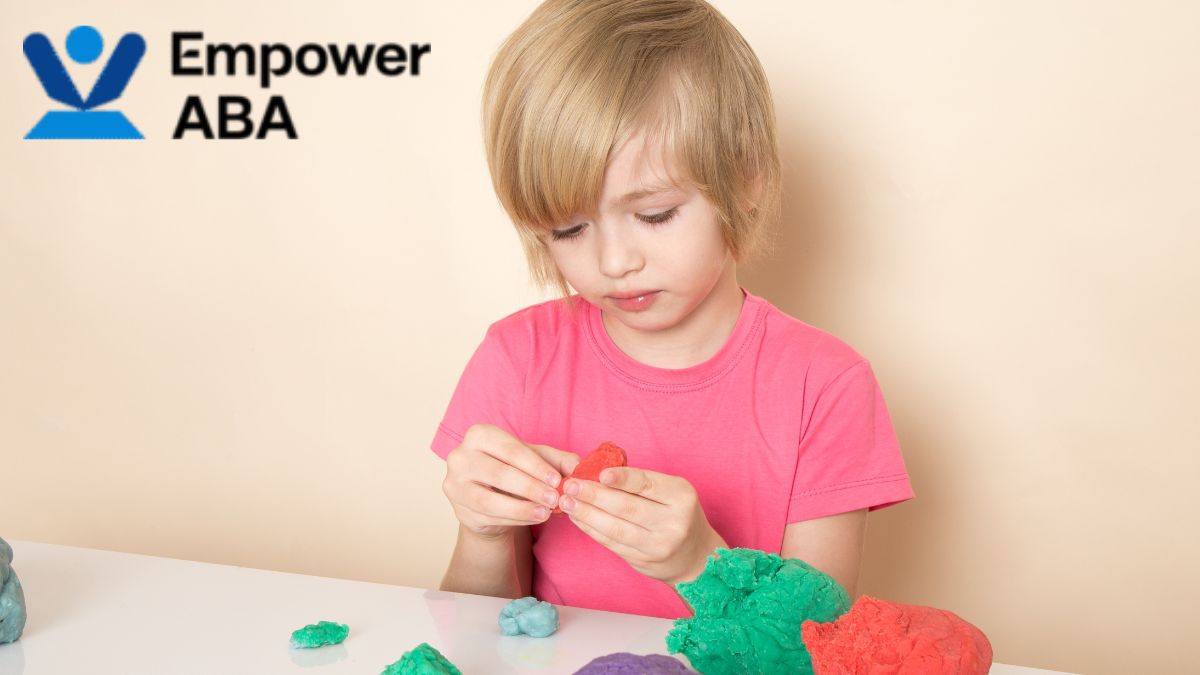Key Points:
- Play schemas reveal how autistic children process learning through repetitive actions.
- Understanding play patterns boosts sensory regulation, confidence, and communication skills.
- Supporting schema play encourages problem-solving, creativity, and meaningful developmental growth.
Play is more than fun; it’s a window into how children think, learn, and explore. For children with autism, play schemas autism can reveal how they make sense of their world. By observing repeated patterns of play, we can see what excites them most and how they naturally engage with ideas, objects, and people. Understanding these patterns is key to supporting learning, problem-solving, and development. Through play schemas, children experiment with motion, containment, transformation, and connection in ways that feel intuitive and meaningful to them. Recognizing these patterns helps adults create environments that enhance growth without disrupting flow.
What Are Play Schemas?

Play schemas are repeated actions or patterns children use to explore ideas through play. Think of them as experiments in motion, structure, or change. These behaviors are not random, they are children testing theories:
- Trajectory: What happens if I throw this?
- Containment: Can this fit inside that?
- Transformation: How can I change it?
Studies show that children with autism often engage in schematic play for longer and more intensely than neurotypical peers (Westby, 2022). This makes understanding play schemas autism essential for supporting sensory, cognitive, and social growth. When recognized and supported, these patterns become powerful tools for learning.
The Nine Core Play Schemas
Researchers and educators typically focus on nine primary schemas. Below is a concise table summarizing them:
| Schema | Definition | Examples | Skills Developed |
| Trajectory | Interest in how objects move | Throwing balls, dropping marbles | Spatial awareness, cause-effect |
| Positioning | Ordering or arranging objects | Lining up toys, stacking blocks | Patterns, organization |
| Transporting | Moving objects or self | Pushing trucks, carrying toys | Planning, coordination |
| Connecting | Joining objects | Linking train cars, LEGO | Problem-solving, creativity |
| Transforming | Changing materials or shapes | Mixing paint, molding clay | Experimentation, observation |
| Rotating | Spinning or twisting | Wheels, hula hoops | Motor skills, cause-effect |
| Enclosing | Creating boundaries | Building walls, fences | Spatial awareness, containment |
| Enveloping | Covering objects or self | Blankets, wrapping items | Predictability, comfort |
| Orientation | Exploring perspective | Climbing, hanging upside down | Body awareness, exploration |
Each schema offers unique developmental benefits and provides insight into a child’s interests. By observing which schemas a child engages in, adults can tailor activities to extend learning naturally.
Real-Life Examples of Play Schemas Autism

Let’s explore these schemas in action with children on the autism spectrum.
1. Trajectory Schema
Eli loves tossing balls into buckets. He experiments with different distances and speeds. Through this, Eli develops spatial awareness and cause-and-effect understanding. A 2021 study found that children with ASD who engage in trajectory play demonstrate better hand-eye coordination and understanding of motion concepts (Kasari et al., 2021).
Activities to Support Trajectory Play:
- Water droppers and trays
- Marble runs and ramps
- Beanbag target toss
2. Containing/Enveloping Schema
Lila enjoys filling boxes with toys and covering them with cloth. This behavior helps her explore object permanence, predictability, and control. Containing behaviors can provide calming sensory input for children with ASD (Fazlioğlu & Baran, 2020).
Suggested Activities:
- Nesting or stacking containers
- Hide-and-seek with small toys
- Sorting boxes by color or size
3. Positioning Schema
Noah lines up toy cars by color and size every morning. While it may seem repetitive, he is practicing categorization, pattern recognition, and fine motor coordination. Observational studies confirm that positioning schemas support problem-solving and cognitive sequencing in children with autism (Westby, 2022).
Suggested Activities:
- Sorting objects into groups
- Building patterned block structures
- Organizing art supplies by type or color
4. Transporting Schema
Sofia constantly moves small objects from one side of the room to another. This repetitive motion is not just play; it reinforces spatial planning, memory, and understanding of movement. Interventions that incorporate transporting schemas can enhance executive functioning skills (JASPER Program, 2020).
Suggested Activities:
- Push carts with toys or blocks
- Role-play errands involving movement of objects
- Create small obstacle courses to transport items
5. Connecting Schema
Lucas enjoys linking toy train cars repeatedly. This schema promotes fine motor skills, problem-solving, and understanding relationships between objects. Research shows that connecting schemas are often linked with creativity and early engineering concepts (Athey, 2007).
Suggested Activities:
- LEGO or magnetic blocks
- Tying or taping crafts
- Linking shapes or rings
6. Transforming Schema
Maya experiments by mixing paint, molding clay, and even melting ice. Transforming schemas fosters curiosity, scientific thinking, and observation skills. A 2022 study suggests that repeated material transformation supports symbolic play development in children with ASD (Westby, 2022).
Suggested Activities:
- Mixing colored water
- Clay modeling and shaping
- Baking or cooking simple recipes
7. Rotating Schema
Liam spins tops and wheels or even twirls scarves around himself. Rotation schemas promote motor coordination and cause-effect understanding. Spinning toys offer predictable feedback, which can be soothing and rewarding for children with autism (Fazlioğlu & Baran, 2020).
Suggested Activities:
- Spin art with paint
- Rolling balls on inclined planes
- Using toys with gears or wheels
8. Enclosing Schema
Chloe builds fences around sandcastles and uses blocks to create small walls. Enclosing schemas support spatial reasoning, boundary recognition, and problem-solving. Engaging in enclosing activities allows children to predict outcomes and understand space more deeply.
Suggested Activities:
- Sandbox boundaries for small toys
- Block fences or walls
- Creating pen spaces for animals or dolls
9. Orientation Schema
Ethan explores by hanging upside down, crawling under tables, or looking at toys from different angles. Orientation schemas enhance body awareness, perspective-taking, and sensory integration. Studies show that children with ASD benefit from schema activities that challenge spatial perspectives while remaining safe and controlled (Westby, 2022).
Suggested Activities:
- Obstacle courses
- Safe climbing structures
- Mirrors for body orientation
Why Play Schemas Are Key for Neurodivergent Learners
Schemas are especially meaningful for:
- Autistic children
- Learners with developmental delays
- Non-speaking or sensory-seeking individuals
These learners may engage in schematic play for longer periods and in more creative, intense ways. When misunderstood, these behaviors can be seen as “disruptive” or “obsessive.” But when recognized and supported, this is exactly how they learn best. Providing safe, sensory-rich play experiences helps them regulate, focus, and engage fully.
Key Benefits of Play Schemas:
- Deepens Learning: Children explore ideas that naturally interest them, making learning meaningful and memorable.
- Builds Problem-Solving Skills: Repetitive exploration encourages testing ideas, refining strategies, and developing critical thinking.
- Supports Sensory Regulation: Predictable patterns of play help children with autism manage sensory input and feel more secure.
- Enhances Social Skills: Schema play in groups promotes turn-taking, cooperation, and communication.
- Fosters Creativity: Children mix and match schemas in new ways, experimenting and innovating freely.
- Improves Engagement and Skill Transfer: Studies show schema-focused interventions boost attention, joint engagement, and the ability to apply skills across settings (Westby, 2022; Kasari et al., 2021).
Tips for Supporting Schema Play
Here are practical ways to foster development while respecting children’s natural play flow:
- Observe before intervening; notice repeated patterns.
- Offer safe alternatives that match the schema interest.
- Introduce new materials to expand exploration subtly.
- Avoid interrupting flow unless safety is an issue.
- Encourage multiple schemas when children are ready.
Schema-based activities are not about controlling play, they are about scaffolding learning through interest-driven engagement. When supported appropriately, children learn better and explore more confidently.
FAQs: Understanding Play Schemas in Autism
1. Can children explore more than one schema at a time?
Yes! Many children combine multiple schemas. For example, they may spin a wheel (rotation) and move it across a table (trajectory) simultaneously.
2. Do play schemas change as children grow?
Absolutely. Schemas evolve with age and skill development. Early trajectory play might progress to complex physics experiments in older children.
3. Are all children with autism interested in schemas?
While intensity varies, most children with autism naturally engage in one or more schemas. Some schemas, like containment or rotation, may be more prominent due to sensory preferences.
4. How do schemas differ from pretend play?
Schemas focus on repeated actions and exploration, while pretend play emphasizes imagination and role-play. Both can intersect but serve different developmental purposes.
5. Can schema play support academic skills?
Yes! Trajectory play can enhance math and physics concepts. Positioning and connecting schemas promote spatial reasoning and engineering foundations.
Unlocking the Power of Play Schemas

Understanding play schemas in autism changes how we see children’s play. At Empower ABA, we know repetitive, focused behaviors are not just quirks, they are a child’s natural way of exploring their world. Watching and supporting these patterns helps children engage deeply with their interests while building creativity, problem-solving, and sensory skills. By guiding these behaviors thoughtfully, children gain confidence and develop skills at their own pace. Whether in structured sessions or free play, schema-driven activities create meaningful learning moments. Families in New York can see how schema-focused strategies make play purposeful and enriching. At Empower ABA, we support every step of this journey. Reach out to us to explore personalized ways to nurture your child’s play, turning curiosity into growth, joy, and lasting learning.

